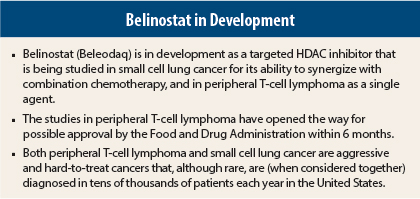In February, the U.S. Food and Drug Administration (FDA) granted belinostat (Beleodaq), a targeted histone deacetylase (HDAC) inhibitor, priority review status based on a pivotal phase II trial in peripheral T-cell lymphoma. Just 1 month later, researchers at the National Cancer Institute (NCI) in Bethesda, Maryland, reported that belinostat combined with simultaneous chemotherapy in a phase I trial had produced partial responses in solid tumors, including small cell lung cancer.
Plans for a multicenter, randomized phase II trial are now under discussion, according to Sanjeeve Bala, MD, a staff clinician in the Developmental Therapeutics Branch at NCI’s Center for Cancer Research, who reported the phase I results at the 12th International Congress on Targeted Anticancer Therapies,1 hosted by Georgetown’s Lombardi Cancer Center in Washington, DC, March 5–7.
Both peripheral T-cell lymphoma, which is a type of non-Hodgkin lymphoma, and small cell lung cancer are aggressive, hard-to-treat cancers that, although rare, are (when considered together) diagnosed in tens of thousands of patients each year in the United States. Belinostat is being studied in small cell lung cancer for its ability to synergize with combination chemotherapy and in peripheral T-cell lymphoma as a single agent. Its success in early trials has raised hope that patients may soon have expanded treatment options. In the case of peripheral T-cell lymphoma, that could be very soon; the FDA’s decision, under the priority review process, is due August 9.
Small Cell Lung Cancer
For small cell lung cancer, the NCI researchers used an infusional form of belinostat and delivered it simultaneously with the standard chemotherapy drugs etoposide and cisplatin. Although it was a phase I, dose-finding trial in relapsed or advanced disease, partial responses were seen in 7 of 26 participants, 13 of whom completed six cycles. Three of the four patients with small cell lung cancer who completed six cycles had partial responses.
The availability of a continuous infusional regimen for this agent may be the key to its success in this setting, said Dr. Bala. Continuous intravenous administration allows the targeted agent to be given simultaneously with chemotherapy. And that appeared to be more effective than sequential administration in preclinical studies, which were conducted by the laboratory of Susan Bates, MD, Head of Molecular Therapeutics in the Medical Oncology Branch at NCI, who developed the current research protocol.
The effectiveness of simultaneous rather than sequential administration is plausible in light of what is known about how HDAC inhibitors work, Dr. Bala noted. Inhibitors like belinostat block HDAC, thereby increasing transcription and making more cancer cell DNA available for destruction by the chemotherapy drugs. Simultaneous administration of chemotherapy and belinostat could optimize this synergy. Other mechanisms may also be at play, Dr. Bala added, as blocking HDAC, in addition to increasing transcription, could influence various other functions that lead to cell death. One aspect that lent further support to the trial, he said, was the observation that small cell lung cancer cells were also very sensitive to belinostat alone.
The next step for belinostat in small cell lung cancer is still under discussion but will probably be a randomized phase II trial comparing simultaneous intravenous belinostat and chemotherapy to chemotherapy alone. “We are still in the process of thinking through these plans,” Dr. Bala said, “but it will need to be a multicenter trial.” Such a trial is expected to enroll relapsed patients with small cell lung cancer and perhaps patients with small cell cancers from other primary sites.
Peripheral T-Cell Lymphoma
Belinostat was used as a single agent in the peripheral T-cell lymphoma trial, a randomized phase II study involving 129 patients with recurrent or relapsed disease, first reported at the 2013 ASCO Annual Meeting.2 Known as the BELIEF trial, this investigation was led by Owen A. O’Connor, MD, PhD, Professor of Medicine and Experimental Therapeutics, and Director of the Center for Lymphoid Malignancies at Columbia University Medical Center in New York.
The BELIEF trial showed an overall response rate of 26% to 28% among all participants. In patients with platelet counts above 100,000/μL, the rate was 28%, and in patients with a subtype of peripheral T-cell lymphoma called angioimmunoblastic T-cell lymphoma, it was 45.5%. In this study, belinostat was administered as an intravenous infusion on a daily-for-5-days schedule.
One advantage to belinostat in this setting may be its low toxicity. Compared to other agents with activity in peripheral T-cell lymphoma, it is less toxic to bone marrow, an advantage especially in previously treated patients who may have poor bone marrow reserve. Its safety profile also makes it potentially easier to combine with chemotherapy, according to Topotarget A/S, the Scandinavian-based company that is developing the drug along with its U.S. partner, Spectrum Pharmaceuticals.
While the FDA has granted belinostat priority review, the company has also moved ahead to lay the groundwork for a phase III trial that would confirm and extend the findings in the BELIEF trial. The plan is to study belinostat combined with the quartet of chemotherapy drugs known as CHOP (cyclophosphamide, doxorubicin, vincristine, and prednisone). The combination (BelCHOP) will be compared to a control group treated with CHOP alone. The peripheral T-cell lymphoma phase III trial is expected to begin in 2015, TopoTarget said in a statement. ■
Disclosure: Drs. Bala, Bates, and O’Connor reported no potential conflicts of interest.
References
1. Bala S, Bryla C, Redon C, et al: Phase I trial of belinostat, a potent histone deacetylase inhibitor (HDI), in combination with cisplatin (Cis) and etoposide (Etop). International Congress on Targeted Anticancer Therapies. Abstract O3.4. Presented March 5, 2014.
2. O’Connor OA, Masszi T, Savage KJ, et al: Belinostat, a novel pan-histone deacetylase inhibitor (HDACi), in relapsed or refractory peripheral T-cell lymphoma (R/R PTCL): Results from the BELIEF trial. 2013 ASCO Annual Meeting. Abstract 8507. Presented June 1, 2013.





